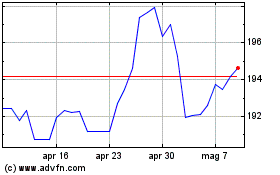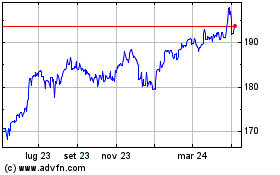UK Economy Stagnates In January
11 Marzo 2020 - 7:32AM
RTTF2
Despite Boris Johnson's election win, the UK economy stagnated
in January as the expansion in the service sector was offset by
falling industrial and construction output, data from the Office
for National Statistics revealed Wednesday.
Gross domestic product remained flat on month in January after
expanding 0.3 percent in December. Economists had forecast a
monthly growth of 0.2 percent.
For third consecutive time, GDP was flat in three months to
January from the previous three months. "Growth in construction,
driven by housebuilding, offset yet another decline in
manufacturing, particularly the drinks, cars and machinery
industries," ONS Head of GDP, Rob Kent-Smith said.
Ahead of the release from the ONS, the Bank of England
unexpectedly cut its key interest rate and launched a new funding
scheme for small businesses as it expects the UK economy to take a
major hit due to the coronavirus, or Covid-19, outbreak.
Policymakers unanimously decided to cut the bank rate by 50
basis points to a record low 0.25 percent.
The BoE said activity is likely to weaken materially in the
United Kingdom over the coming months.
The Chancellor of the Exchequer will present his Budget to
Parliament later today. The new chancellor Rishi Sunak is likely to
provide additional funds to the NHS and households amidst the
spread of coronavirus. The Chancellor is widely expected to stick
to the fiscal rules.
The ONS data showed that the growth in the dominant service
sector slowed to 0.1 percent in January from 0.3 percent in
December. The main drag on growth was information and
communication.
Driven by weak energy output, industrial production fell
unexpectedly by 0.1 percent, reversing a 0.1 percent growth a month
ago. Output was forecast to grow 0.3 percent.
Manufacturing output expanded at a slower pace of 0.2 percent,
in line with expectations, after December's 0.3 percent
increase.
At the same time, construction output plunged 0.8 percent in
January, in contrast to a 0.4 percent rise in December.
On a yearly basis, industrial production fell 2.9 percent after
easing 1.8 percent in December. Likewise, manufacturing slid 3.6
percent versus a 2.5 percent drop in December.
Economists had forecast industrial output to fall 2.6 percent
and manufacturing to decline 3.5 percent.
Another data from ONS showed that the visible trade gap widened
to GBP 3.72 billion from GBP 1.41 billion in December. Exports of
goods fell 5.6 percent from December, while imports grew 0.7
percent.
Meanwhile, the surplus on services increased to GBP 7.93 billion
from GBP 7.69 billion in the previous month.
Consequently, the overall trade balance showed a surplus of GBP
4.21 billion compared to GBP 6.27 billion in December.
Grafico Cross Sterling vs Yen (FX:GBPJPY)
Da Mar 2024 a Apr 2024

Grafico Cross Sterling vs Yen (FX:GBPJPY)
Da Apr 2023 a Apr 2024
